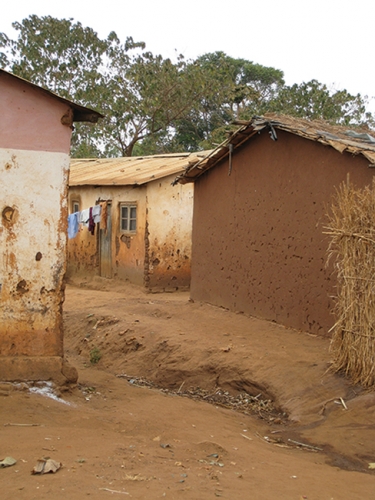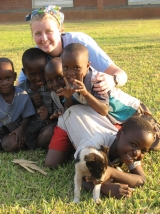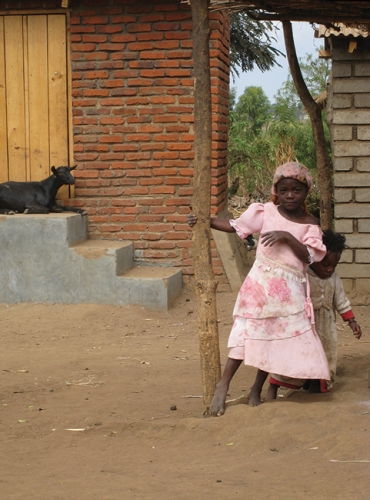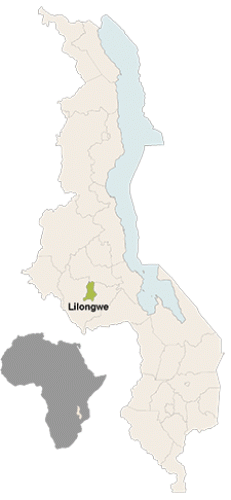All Cameron Taylor needed was a place to sit.
The nurses of the Area 18 clinic in Lilongwe, Malawi, rummaged through a closet. They brought back a metal frame with an attached bowl and a plastic toilet seat — a potty chair. Taylor perched on the potty with her laptop and got to work sifting through years of medical records.
Taylor, a UNC undergrad, went to Lilongwe in the summer of 2008 to help lay the groundwork for a Phase III clinical trial of the most promising malaria vaccine to date. Like most other sub-Saharan countries, Malawi is hard-hit by malaria, and the vaccine trial is gaining popularity among Malawians. But this isn’t your standard clinical trial. Run by the Malaria Vaccine Initiative and pharmaceutical company GlaxoSmithKline, it’s a double-blind trial with sixteen thousand kids — and a bunch of geographers.
A trial trial

Photo by Cameron Taylor. ©2010 Endeavors magazine.
Typical housing in the Mtandire village outside of Lilongwe, Malawi. Trenches near houses collect water during the rainy season and create a breeding ground for mosquitoes.

Click to read photo caption. Photo by Cameron Taylor. ©2010 Endeavors magazine.
Years ago researchers noticed that in different trials the same vaccine could give completely different results. In one trial a typhoid vaccine protected 80 percent of people; in another it only protected 20 percent. “Some vaccines just work, like the smallpox vaccine,” Michael Emch says. “A no-brainer, right? Use it. And then some don’t work at all and you know you shouldn’t use them. But then there’s everything else.”
Vaccine trials usually compare how many people get the disease in a vaccinated group to a group given a placebo. But Emch thinks researchers should consider more factors, such as where the participants live, whether they’re exposed to the disease, and how frequently they’re exposed. “Maybe there’s some sort of pattern to the communities where a vaccine doesn’t work well and where it works really well,” Emch says. What if those patterns could be changed to make the vaccine work better?
Emch and his team of medical geographers have been developing new clinical-trial methods in a field called spatial epidemiology, which he hopes will lead to a better understanding of vaccine efficacy. After years of successful work on cholera vaccine trials in Bangladesh he was called to work on a huge malaria vaccine trial going on in Africa.
GlaxoSmithKline and other researchers reported encouraging Phase II clinical-trial results in 2007 for their malaria vaccine. It was given to two thousand infants and young children — the people most vulnerable to the disease — and it protected 53 and 65 percent of them, respectively, against malaria. This past summer, a Phase III clinical trial began at eleven African sites, one of which is the UNC site in Lilongwe.
Carolina has a good track record of trials in Malawi, Irving Hoffman says. Hoffman, the director of international operations for UNC’s Institute for Global Health and Infectious Diseases, set up a clinic for sexually transmitted diseases there in 1989 and is now helping oversee the malaria trial. “Our research there started really small, and then we wrote more and more grants and got more broad-based,” Hoffman says.
Emch and Hoffman have their work cut out for them. Recruiting, screening, vaccinating, and keeping track of sixteen thousand children in a developing country isn’t easy.
Welcome to Malawi; pull up a seat

Photo courtesy of Cameron Taylor. ©2010 Endeavors magazine.
Undergraduate Cameron Taylor spent two summers in Malawi collecting data for a malaria vaccine trial. Each week, she took time out to play soccer with the neighborhood boys.

Click to read photo caption. Photo courtesy of Cameron Taylor. ©2010 Endeavors magazine.
In that first summer of 2008, Taylor’s goals were to help establish which villages would take part in the trial and then train community-health workers to use GPS devices.
The trial is centered on the Area 18 clinic, named after its census designation. “It’s a little clinic where they do vaccinations and primary care stuff,” Taylor says. She set out to go through the clinic’s record books and find out where its patients were coming from. Her first day, she asked the nurses for their books. “They went into a cabinet in the maternity ward and started digging through these big books, not organized, just crammed full of binders,” Taylor says. They brought out the shabby pile of records and pointed her to an empty receptionist area at the entrance to the maternity ward.
There, on the potty chair, Taylor read through patient files. “What was interesting was that women were coming from a lot farther away than we expected,” Taylor says. “Most of these women are pregnant, they have a sick baby on their back, and they’re walking here at five in the morning to see a doctor.”
But knowing which villages the women were coming from wasn’t enough. “Places don’t have simple addresses in Malawi,” Taylor says. When patients come into the clinic they don’t list their street address; they draw a map to their house on the back of a medical form. “And the directions are pretty much, ‘Go down this street, find so-and-so and then they’ll tell you how to get to me,’” Taylor says.
Since hundreds of children in the trial would need to be carefully monitored, hand-drawn maps and convoluted directions wouldn’t be good enough. “We have to know about every single illness they have and then test them for malaria, so we have to have clear access to them,” Hoffman says.
So Emch and Taylor handed out tracking devices to the field workers. “They’re little hundred-dollar GPS devices you use to mark a point — and, what’s really great, you can navigate back to that point,” Taylor explains. “That’s great for the field team because in the past they used to spend hours and hours asking people, ‘Where’s so-and-so?’”
The Malawian community-health workers had trouble at first with the GPS devices. “It’s a new idea and they’re so dependent on paper,” Taylor says. To help the workers practice, Taylor set up scavenger hunts around the clinic with secret locations that they’d have to find with their GPS devices. By the end of the summer the field workers had embraced the technology and Taylor left hoping that they would continue to collect coordinates.
Let’s rock and roll

Photo by Cameron Taylor. ©2010 Endeavors magazine.
Worldwide, malaria kills between one million and three million people per year. The majority are children in sub-Saharan Africa.

Click to read photo caption. Photo by Cameron Taylor. ©2010 Endeavors magazine.
In June 2009, Taylor and graduate student Sophia Giebultowicz headed back to Lilongwe to help with recruitment for the beginning of the trial. “I don’t know if it was their plan to get me involved in Malawi as a sophomore with the intention of bringing me back my junior year, but if it was, I definitely took the bait,” Taylor says. The real enticement came around February, when she found out that the community-health workers had kept up with using the GPS devices, and coordinates were coming in.
Researchers started to spread the word about the trial around the community. “We collaborate with the Ministry of Health in Malawi and the Malaria Control Program, which helps us talk to women in the clinic, put up fliers, and set up sensitization talks,” Hoffman explains.
Emch and Taylor went with the head community-health worker, Mercy Tsidya, to one of the sensitization talks used to recruit mothers into the trial. “There are actually these public health songs that they sing. I mean, they are rocking out: there’s clapping and singing, and everybody knows these songs,” Emch says. “Then Mercy gives her spiel about the malaria trial.”
“The community-health workers are just amazing,” Taylor says. “They really know how to explain what a vaccine is so people will understand.”
Soon, women in the villages started recognizing the malaria field workers. “Women would hold their babies up and say, ‘Choose mine, mine wants to be in the trial!’” Taylor says. “It just shows how much of a burden malaria is there.”
Would you like to take a survey?

Photo by Cameron Taylor. ©2010 Endeavors magazine.
Some homes in Malawi are more vulnerable to mosquitoes than others. Community-health workers note housing conditions to understand the environments of the children in the trial and the efficacy of the vaccine.

Click to read photo caption. Photo by Cameron Taylor. ©2010 Endeavors magazine.
In August of 2009 the research team gave out the first round of vaccine. Giebultowicz and Taylor planned how to collect data about factors in the children’s environments that could affect the vaccine’s performance.
There are a lot of things that influence how well the vaccine works for a given person: how often she gets bitten by mosquitoes that carry the malaria bug, how many people in her village have malaria, how many mosquitoes can get into her house because of its design or building materials, and whether people from her village visit other villages where a lot of people are sick with malaria.
“We approached this,” Giebultowicz explains, “by saying there needs to be some sort of method to compare a child who has been vaccinated but sleeps without a mosquito net in a house that doesn’t have secure walls with another vaccinated child who does sleep under a net and lives in a cement house with glass windows.”
They designed a questionnaire for the families of vaccinated children. The first part asked simple questions for the head of the household, such as, “Does your child sleep under a bed net?” and “Has anyone in the household traveled outside of Lilongwe in the past month?” The second part of the questionnaire, completed by the field workers, was about things around the house, such as stagnant water, nearby vegetation, and the building materials of the house. Hoffman explains that they ask about housing materials not only to determine whether mosquitoes can get into the house, but also to collect information about socioeconomic status. “If you live in a really nice brick home with screens and windows, you’re probably richer than a person with a thatched roof, no screens, and open windows,” Hoffman says. Your socioeconomic status and that of your neighbors could be a risk factor for malaria infection as well.
“At the same time, there are transmission-intensity studies going on,” Hoffman adds. “We’ll be collecting mosquitoes and then looking at the type and percentage that have malaria in order to determine a bite rate at different sites.”
And then they wait. Emch and Giebultowicz hope to have environmental data to analyze in the spring of 2010.
In the meantime, Taylor and Giebultowicz have been layering satellite images onto geographic databases. “They’ve mapped out things about the local environment such as where swamps are and where bodies of water are,” Emch says.
Taylor has also compiled trial-participant information into a free, interactive mapping program called ArcReader. Now the field workers can plan their daily home visits by clicking on a map and pulling up information about any child in the trial. “I’m writing an article right now on the software and how amazing it is for developing countries because it’s free and easy to use,” Taylor says.
Hoffman can already see the benefit of having the spatial-epidemiology data in the trial and is looking forward to seeing the results. “A lot of things in research go round and round and have little impact. You just keep trudging along,” he says. “But this is really an opportunity. If this vaccine continues to show the efficacy that it did in the Phase II and leads to licensure, then it’ll save a lot of lives.”










